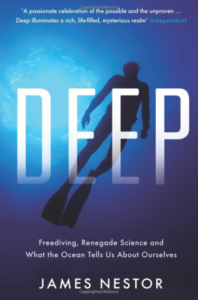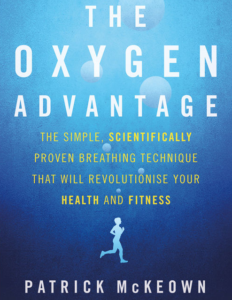Stop Breathing to Run Faster
At 50m the air a scuba diver breathes, starts to slowly and painfully poison them. A single but very long breath can enable a freediver to sink a whopping 200 toxic metres.
![Photo by [Israel Gil]](/assets/images/2021/06/israel-gil-cBBLR2b58Qg-unsplash-1.jpeg)
While freediving has its attractions, my extraordinarily buoyant body precludes me from this activity.
This hasn’t stopped me from gathering a small collection of freediving books and an assortment of apnea iPhone apps in a quest to hold my breath for an extraordinary length of time.
The latest obsession with breath holding follows a really interesting podcast by Ben Greenfield where he was talking to a freediver about the mammalian dive reflex and apnea tables. I didn’t know much about either.
As part of his training, the freediver regularly runs intervals on his treadmill, gradually picking up speed while holding his breath before breathing again on the rest cycle. This apparently helps him to dive deeper and deeper into the ocean’s mysterious depths.
Much as I am intrigued by the ocean, I don’t think I’m ever going to be a freediver, however, I am interested in whether I could significantly improve my breath hold abilities and whether an improved performance there, could translate to improved running efficiency.
While I don’t think I’ll ever take up free diving, I’m rather too buoyant to get anything more than my face under water, I am keen to ensure that if the worst came to the worst, and I was ever trapped in a sinking vessel, I might have more than 20 seconds of lung capacity to enable me to swim to freedom.
![Photo by [NOAA]](/assets/images/2021/06/noaa-e0eHtnr7eeU-unsplash-2.jpeg)
Training advice on assorted free diving websites suggests that regular training from the comfort of your sofa, could result in a 3 minute breath holding ability within 3 months.
That is pretty impressive and whether it would have knock effects for running or not, it sounds like a worthy task to exploit ones physiological potential. It reminds me of the yogis who can depress their heart rates so low that they can feign death for ages. That’s another skill that I can imagine being extremely useful in disaster situation.
Although you can hold your breath longer under water, this breath hold training is best completed from the sofa rather than the pool because it is dangerous and foolhardy to push your breath hold limits in the vicinity of water. The Mammalian Dive Reflex means you can hold your breath longer while ever your eyes are under water and it also means if you pass out, your final breath will be a massive gulp of water to the lungs and you’ll be dead.
Apparently if you pass out while breath holding under water. You won’t breath immediately. You will however start to sink, and if someone doesn’t fish you out of the water, your body will eventually take its final breath! Not to be advised.
If you are lucky enough to get pulled out before your last breath, a skilled rescuer will know to blow across your eyes, to alert the body that you are no longer submerged and that it is safe to breathe again.
Anyway, you can rest assured that if you can hold your breath for 3 minutes on dry land, you are going to be able to eke out a few more seconds in a sinking ship scenario.
Having been inspired by the podcast I went in search of other material and went on to read Deep by James Nestor, which is a pretty impressive piece of journalism, a sort of Born to Run for Freedivers.
Free diving sounds exciting, but as a spectator sport it has the potential to be more than stultifying. A diver bobs below the surface and soon descends out of sight. The Marshall counts down, then counts up and maybe 3 mins later the diver reappears. It sounds dull I think, but on the authors first visit to the world champs most of the divers passed out in the depths and needed to be retrieved, one went AWOL as he lost his ankle tether and was feared dead and others came up with broken blood vessels smearing their face. That sort heroism adds to the interest but not the appeal.
Now Deep is a really interesting read but its low on transferable advice for runners. For that I recommend The Oxygen Advantage by Patrick McKeown, although you should be aware that Patrick is a breath holding zealot and appears to view it as a cure-all – anything from asthma to obesity.
The argument is that most Westerners chronically over breathe, due to mouth breathing and/or sighing and yawning which creates no end of health problems. Fortunately we can learn to calm our breathing and expand what he calls our BOLT score which is a non-extreme breath hold capacity. Most people will experience health and performance benefits by extending their breath hold capacity.
Anyway, the book includes a whole section of breath holding exercises and specific Oxygen Advantage programs including those that stimulate the advantages of high altitude training.
In the pre-lockdown parkrun days, I used his Nasal Unblocking method:
- Take a small, silent breath in and a small silent breath out through your nose
- Pinch your nose with your fingers to hold your breath
- Walk as many paces as possible with your breath held. Try to build up a strong air shortage.
- When you resume breathing, do so only through your nose; your breathing must be calmed immediately.
- After resuming your breathing, your first breath will usually be bigger than normal. Make sure that you calm your breathing as soon as possible by suppressing your second and third breaths.
- You should be able to recover this breath hold within two to three breaths. If you cannot you have held your breath too long.
- Wait about a minute and repeat.
- Repeat this exercise five or six times until the nose is decongested.
I also use an apnea training app on my phone and follow the CO2 tables provided. This are very similar cyclic breath hold exercises but as ever I like the benefit of the automatically recorded progress.
After haphazardly breath holding for a month I increased my maximum breath hold from 30 to 121 seconds (without preliminary Wim Hof breaths). Thats probably not sufficient to escape the sinking ship and only time will tell if it has any short term benefits for my parkrun times but I feel good about it.


